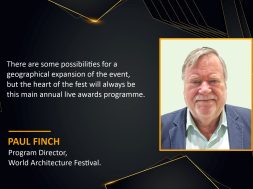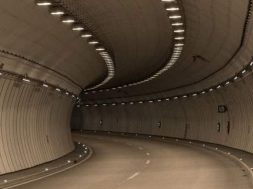Carbon and energy calculations take centre stage in modern architecture

This story features an exclusive interaction with WAF’s Program Director, Paul Finch. He discusses the festival’s history, his views on the emerging trends of architecture, architectural practices in India, and the festival in the years to come.
This festival is making waves in the architecture world, inspiring innovation, and shaping the future of design. Can you please talk more about this?
In 2007, I was the editor of The Architectural Review, an international architecture magazine. When we looked at the international market and events, we found that many architects and designers wanted to participate in events that were primarily real estate events, and they would be bit-part players. When we looked at architects and designers who make the built environment world, we felt there should be an event where they are the stars, the main players. When we did our research, we found that there wasn’t such an event because they either didn’t take place every year or focused on one subject like waterside architecture or one material like concrete. We wanted an annual event that encompassed everything that architects and designers did. When we did our research, we found some good sponsors. Our founder sponsor has been with us to this day since 2008. We also wanted to allow architects to compare and contrast how they were designing things in their country, their geography, their culture, and how their contemporaries did them. That was really the inspiration for the event!

How do you see India’s participation in the World Architecture Festival?
Seeing interesting speakers, judges, and an award entrance from India is nice. I see a mixture of modern methods applied to traditional materials and forms of construction; it is also interesting to witness some completely new things. There is a demand for good architecture because India has a huge middle-class population. I also see an increase in the high-rise housing developments. Indian architects have evolved, and Indian modernism is present in their architecture. When we look at the current trends globally, it is about mixed-use. It is focused on the responses to nature and water. It is remarkable to see that India is also moving in this direction. One of India’s leading architectural firms was a category winner in last year’s event, which is a testimony to this.
We look forward to many contributions from India in the future.
How do you see architecture as a discipline evolving over decades?
Over the years, two notable changes have occurred in the context of a rapidly growing world. First, the increase in high-rise construction across the world, which has accompanied the continuing movement of people from the countryside to cities, is the process of urbanisation. Second, a much greater emphasis on carbon reduction and green policies, greater emphasis on natural biophilic design, more focus on water usage, and a greater focus on recycling, regeneration, and retrofitting. Our architects and designers are addressing challenges as far as they can. But, while they are successful sometimes, some issues are getting bigger each day because of population growth, population shift, and the increase in extractive industries because of population rise in some places. Architects and designers can play their part in addressing these. But, of course, many of them can be resolved only through engineering and technology development, including AI.

What kind of trends are emerging in architectural practice?
Even in the World Architecture Festival, carbon and energy calculations are important criteria for shortlisting project submissions for the awards. But that was not the case 30–40 years ago. The emphasis on a response to nature is a new trend. For example, in Singapore, many buildings have greenery growing all over them. Some regulations enforce such designs. However, this is not the case in many other countries. However, I think such stringent laws will soon be in place in other countries because societies’ attitudes towards nature and ecosystems have changed recently. I see that younger generations are more interested in conservation. The built environment plays a big part there. I think architects and designers have a big role to play.
Talking about inclusion, like you said, architecture is all about going with nature today. How do you envisage the World Architecture Festival in the future?
Our awards programme is the heart of the festival, apart from the conference, which also is highly sought after. The programme is why renowned architects worldwide are here: to take part or to judge. The system is live and not behind closed doors. Delegates can see the presentations in front of international free-person juries. The WAF is the only global event where the awards and judging go live. I think that is the winning formula, and we will keep following this.
There are plans to look at other areas of architecture which are not covered currently. For example, practice management, that is, the business of running architectural practices, particularly larger and international practices, is something we plan to have in the future. Still, we will always be allied to architectural and design values. We also propose to have a few regional events, which may be conferences rather than awards. We recently held the first WAF China event with a Chinese partner and an awards programme. There are some possibilities for geographical expansion, but I think the heart of the fest will always be this main annual live event.
Cookie Consent
We use cookies to personalize your experience. By continuing to visit this website you agree to our Terms & Conditions, Privacy Policy and Cookie Policy.










